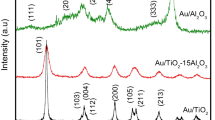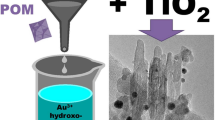Abstract
Au/TiO2, Pd/TiO2, Pt/TiO2 and Rh/TiO2 catalysts were synthesized by the deposition–precipitation with urea (DPU) and sol–gel (SG) methods to elucidate the influence of the preparation method on the catalytic activity in the CO oxidation at low temperature. In all cases, the metal loading was 1 wt%. The effect of the synthesis method was remarkable for the Au/TiO2 and Pd/TiO2 materials and less important for the Pt/TiO2 and Rh/TiO2 materials. However, for the four materials, the DPU method revealed the most active materials at 0 °C with respect to the sol–gel method. Au/TiO2 and Rh/TiO2, obtained by the DPU method, were active at temperatures below 0 °C and showed outstanding catalytic activity in comparison with the Pd/TiO2 and Pt/TiO2 catalysts. Density Functional Theory based calculations on M13/TiO2 (M = Au, Pd, Pt or Rh) structures revealed a superior charge transfer from a defective support to Au, while Rh triggered O2 bond scission in the oxygen vacancy site located in the metal-support interface.











Similar content being viewed by others
References
Boudart M (1969) Catalysis by supported metals**This work was sponsored by grant GK 648 of the nationalscience foundation. Its continuity over the years has been assured by a generous grant from the petroleum research fund of the American chemical society. In: Eley DD, Pines H, Weisz PB (eds). Academic Press, vol 20, pp 153–166
Gerhard E, Helmut K, Ferdi S, Jens W (2008) Handbook of Heterogeneous Catalysis, vol 1, 2nd edn. Wiley‐VCH Verlag GmbH & Co, pp 1283–1357
Eschemann TO, Bitter JH, de Jong KP (2014) Effects of loading and synthesis method of titania-supported cobalt catalysts for Fischer-Tropsch synthesis. Catal Today 228:89–95. https://doi.org/10.1016/j.cattod.2013.10.041
Mor GK, Shankar K, Paulose M et al (2006) Use of highly-ordered TiO2 nanotube arrays in dye-sensitized solar cells. Nano Lett 6:215–218. https://doi.org/10.1021/nl052099j
D’Agata A, Fasulo S, Dallas LJ et al (2014) Enhanced toxicity of “bulk” titanium dioxide compared to “fresh” and “aged” nano-TiO2 in marine mussels (Mytilus galloprovincialis). Nanotoxicology 8:549–558. https://doi.org/10.3109/17435390.2013.807446
Nakata K, Fujishima A (2012) TiO2 photocatalysis: design and applications. J Photochem Photobiol C Photochem Rev 13:169–189. https://doi.org/10.1016/j.jphotochemrev.2012.06.001
Schneider J, Matsuoka M, Takeuchi M et al (2014) Understanding TiO2 photocatalysis: mechanisms and materials. Chem Rev 114:9919–9986. https://doi.org/10.1021/cr5001892
Kominami H, Kato J, Takada Y et al (1997) Novel synthesis of microcrystalline titanium(IV) oxide having high thermal stability and ultra-high photocatalytic activity: thermal decomposition of titanium(IV) alkoxide in organic solvents. Catal Lett 46:235–240. https://doi.org/10.1023/A:1019022719479
Bagheri S, Shameli K, Abd Hamid SB (2013) Synthesis and characterization of anatase titanium dioxide nanoparticles using egg white solution via sol-gel method. J Chem 2013:848205. https://doi.org/10.1155/2013/848205
Palcheva R, Dimitrov L, Tyuliev G et al (2013) TiO2 nanotubes supported NiW hydrodesulphurization catalysts: characterization and activity. Appl Surf Sci 265:309–316. https://doi.org/10.1016/j.apsusc.2012.11.001
Liang G, He L, Cheng H et al (2014) The hydrogenation/dehydrogenation activity of supported Ni catalysts and their effect on hexitols selectivity in hydrolytic hydrogenation of cellulose. J Catal 309:468–476. https://doi.org/10.1016/j.jcat.2013.10.022
Haruta M, Yamada N, Kobayashi T, Iijima S (1989) Gold catalysts prepared by coprecipitation for low-temperature oxidation of hydrogen and of carbon monoxide. J Catal 115:301–309. https://doi.org/10.1016/0021-9517(89)90034-1
Takano S, Tsukuda T (2015) Chapter 2—controlled synthesis: size control. In: Tsukuda T, Häkkinen H (eds) Protected metal clusters. Elsevier, pp 9–38
Yan W, Chen B, Mahurin SM et al (2005) Preparation and comparison of supported gold nanocatalysts on anatase, brookite, rutile, and P25 polymorphs of TiO2 for catalytic oxidation of CO. J Phys Chem B 109:10676–10685. https://doi.org/10.1021/jp044091o
Kaden WE, Kunkel WA, Roberts FS et al (2014) Thermal and adsorbate effects on the activity and morphology of size-selected Pdn/TiO2 model catalysts. Surf Sci 621:40–50. https://doi.org/10.1016/j.susc.2013.11.002
Shahreen L, Chase GG, Turinske AJ et al (2013) NO decomposition by CO over Pd catalyst supported on TiO2 nanofibers. Chem Eng J 225:340–349. https://doi.org/10.1016/j.cej.2013.03.102
Chua YPG, Gunasooriya GTKK, Saeys M, Seebauer EG (2014) Controlling the CO oxidation rate over Pt/TiO2 catalysts by defect engineering of the TiO2 support. J Catal 311:306–313. https://doi.org/10.1016/j.jcat.2013.12.007
Zhang C, Yu H, Li Y et al (2013) Simple synthesis of Pt/TiO2 nanotube arrays with high activity and stability. J Electroanal Chem 701:14–19. https://doi.org/10.1016/j.jelechem.2013.04.012
Guan H, Lin J, Qiao B et al (2016) Catalytically active Rh Sub-nanoclusters on TiO2 for CO oxidation at cryogenic temperatures. Angew Chem Int Ed 55:2820–2824. https://doi.org/10.1002/anie.201510643
Camposeco R, Hinojosa-Reyes M, Castillo S et al (2021) Synthesis and characterization of highly dispersed bimetallic Au-Rh nanoparticles supported on titanate nanotubes for CO oxidation reaction at low temperature. Environ Sci Pollut Res 28:10734–10748. https://doi.org/10.1007/s11356-020-11341-7
Khan I, Saeed K, Khan I (2019) Nanoparticles: properties, applications and toxicities. Arab J Chem 12:908–931. https://doi.org/10.1016/j.arabjc.2017.05.011
Torrente-Murciano L (2016) The importance of particle-support interaction on particle size determination by gas chemisorption. J Nanoparticle Res Interdiscip Forum Nanoscale Sci Technol 18:87. https://doi.org/10.1007/s11051-016-3385-2
Blöchl PE (1994) Projector augmented-wave method. Phys Rev B 50:17953–17979. https://doi.org/10.1103/PhysRevB.50.17953
Kresse G, Joubert D (1999) From ultrasoft pseudopotentials to the projector augmented-wave method. Phys Rev B 59:1758–1775. https://doi.org/10.1103/PhysRevB.59.1758
Kresse G, Hafner J (1993) Ab initio molecular dynamics for liquid metals. Phys Rev B 47:558–561. https://doi.org/10.1103/PhysRevB.47.558
Kresse G, Hafner J (1994) Ab initio molecular-dynamics simulation of the liquid-metalamorphous- semiconductor transition in germanium. Phys Rev B 49:14251–14269
Kresse G, Furthmüller J (1996) Efficient iterative schemes for ab initio total-energy calculations using a plane-wave basis set. Phys Rev B—Condens Matter Mater Phys 54:11169–11186
Kresse G, Furthmüller J (1996) Efficiency of ab-initio total energy calculations for metals and semiconductors using a plane-wave basis set. Comput Mater Sci 6:15–50
Perdew JP, Ruzsinszky A, Csonka GI et al (2008) Restoring the density-gradient expansion for exchange in solids and surfaces. Phys Rev Lett 100:136406. https://doi.org/10.1103/PhysRevLett.100.136406
Dudarev SL, Botton GA, Savrasov SY et al (1998) Electron-energy-loss spectra and the structural stability of nickel oxide: an LSDA+U study. Phys Rev B 57:1505–1509. https://doi.org/10.1103/PhysRevB.57.1505
Grimme S, Ehrlich S, Goerigk L (2011) Effect of the damping function in dispersion corrected density functional theory. J Comput Chem 32:1456–1465. https://doi.org/10.1002/jcc.21759
Torres AE, Rodríguez-Pineda J, Zanella R (2021) Relevance of dispersion and the electronic spin in the DFT + U approach for the description of pristine and defective TiO2 anatase. ACS Omega 6:23170–23180. https://doi.org/10.1021/acsomega.1c02761
Stradi D, Jelver L, Smidstrup S, Stokbro K (2017) Method for determining optimal supercell representation of interfaces. arXiv
Momma K, Izumi F (2011) Vesta for three-dimensional visualization of crystal, volumetric and morphology data. J Appl Crystallogr 44:1272–1276. https://doi.org/10.1107/S0021889811038970
V. Wang, N. Xu, J.C. Liu, G. Tang WTG VASPKIT: A user-friendly interface facilitating high-throughput computing and analysis using VASP code
Henkelman G, Arnaldsson A, Jónsson H (2006) A fast and robust algorithm for Bader decomposition of charge density. Comput Mater Sci 36:354–360
Dimitrakis DA, Tsongidis NI, Konstandopoulos AG (2016) Reduction enthalpy and charge distribution of substituted ferrites and doped ceria for thermochemical water and carbon dioxide splitting with DFT+U. Phys Chem Chem Phys 18:23587–23595. https://doi.org/10.1039/C6CP05073E
Zanella R, Louis C (2005) Influence of the conditions of thermal treatments and of storage on the size of the gold particles in Au/TiO2 samples. Catal Today 107–108:768–777. https://doi.org/10.1016/j.cattod.2005.07.008
Kung HH, Kung MC, Costello CK (2003) Supported Au catalysts for low temperature CO oxidation. J Catal 216:425–432. https://doi.org/10.1016/S0021-9517(02)00111-2
Zanella R, Delannoy L, Louis C (2005) Mechanism of deposition of gold precursors onto TiO2 during the preparation by cation adsorption and deposition–precipitation with NaOH and urea. Appl Catal A Gen 291:62–72. https://doi.org/10.1016/j.apcata.2005.02.045
Haruta M (2002) Catalysis of gold nanoparticles deposited on metal oxides. CATTECH 6:102–115. https://doi.org/10.1023/A:1020181423055
McCafferty E, Wightman JP (1998) Determination of the concentration of surface hydroxyl groups on metal oxide films by a quantitative XPS method. Surf Interface Anal 26:549–564. https://doi.org/10.1002/(SICI)1096-9918(199807)26:8%3c549::AID-SIA396%3e3.0.CO;2-Q
Kruse N, Chenakin S (2011) XPS characterization of Au/TiO2 catalysts: binding energy assessment and irradiation effects. Appl Catal A Gen 391:367–376. https://doi.org/10.1016/j.apcata.2010.05.039
Yang J, Bai H, Tan X, Lian J (2006) IR and XPS investigation of visible-light photocatalysis—nitrogen–carbon-doped TiO2 film. Appl Surf Sci 253:1988–1994. https://doi.org/10.1016/j.apsusc.2006.03.078
McClory MM, Gonzalez RD (1986) Catalytic oxidation of carbon monoxide over ruthenium-rhodium (RuRh)silica bimetallic clusters. J Phys Chem 90:628–633. https://doi.org/10.1021/j100276a029
Raj R, Harold MP, Balakotaiah V (2015) Steady-state and dynamic hysteresis effects during lean co-oxidation of CO and C3H6 over Pt/Al2O3 monolithic catalyst. Chem Eng J 281:322–333. https://doi.org/10.1016/j.cej.2015.06.057
Voogt EH, Mens AJM, Gijzeman OLJ, Geus JW (1996) XPS analysis of palladium oxide layers and particles. Surf Sci 350:21–31. https://doi.org/10.1016/0039-6028(96)01028-X
Kukovecz Á, Pótári G, Oszkó A et al (2011) Probing the interaction of Au, Rh and bimetallic Au–Rh clusters with the TiO2 nanowire and nanotube support. Surf Sci 605:1048–1055. https://doi.org/10.1016/j.susc.2011.03.003
Pérez-Ramírez J, Kondratenko EV, Novell-Leruth G, Ricart JM (2009) Mechanism of ammonia oxidation over PGM (Pt, Pd, Rh) wires by temporal analysis of products and density functional theory. J Catal 261:217–223. https://doi.org/10.1016/j.jcat.2008.11.018
Ekou T, Ekou L, Vicente A et al (2011) Citral hydrogenation over Rh and Pt catalysts supported on TiO2: influence of the preparation and activation protocols of the catalysts. J Mol Catal A Chem 337:82–88. https://doi.org/10.1016/j.molcata.2011.01.020
Sandoval A, Aguilar A, Louis C et al (2011) Bimetallic Au–Ag/TiO2 catalyst prepared by deposition–precipitation: high activity and stability in CO oxidation. J Catal 281:40–49. https://doi.org/10.1016/j.jcat.2011.04.003
Scirè S, Minicò S, Crisafulli C, Galvagno S (2001) Catalytic combustion of volatile organic compounds over group IB metal catalysts on Fe2O3. Catal Commun 2:229–232. https://doi.org/10.1016/S1566-7367(01)00035-8
Altass HM, Khder AERS (2018) Catalytic oxidation of carbon monoxide over of gold-supported iron oxide catalyst. Mater Res Innov 22:107–114. https://doi.org/10.1080/14328917.2016.1264707
Wang Y-G, Yoon Y, Glezakou V-A et al (2013) The role of reducible oxide-metal cluster charge transfer in catalytic processes: new insights on the catalytic mechanism of CO oxidation on Au/TiO2 from ab initio molecular dynamics. J Am Chem Soc 135:10673–10683. https://doi.org/10.1021/ja402063v
Tanaka S, Lin J, Kaneti YV et al (2018) Gold nanoparticles supported on mesoporous iron oxide for enhanced CO oxidation reaction. Nanoscale 10:4779–4785. https://doi.org/10.1039/C7NR08895G
Wang Y-G, Mei D, Glezakou V-A et al (2015) Dynamic formation of single-atom catalytic active sites on ceria-supported gold nanoparticles. Nat Commun 6:6511. https://doi.org/10.1038/ncomms7511
Acknowledgements
The authors want to thank the financial support provided by the Consejo Nacional de Ciencia y Tecnología (CONACYT) through the CB A1-S-18269 grant, Dirección General de Asuntos del Personal Académico-UNAM through the PAPIIT IN104022 grant. We also thank V. Maturano for technical support. A. E. Torres gratefully acknowledges DGTIC-UNAM for the use of supercomputer facilities through the project LANCAD-UNAM-DGTIC-401 and UNAM for funding through the project DGAPA-PAPIIT IA202521, which have contributed to the theoretical results reported in this paper.
Author information
Authors and Affiliations
Corresponding author
Ethics declarations
Conflict of interest
The authors declare that they have no conflict of interest.
Additional information
Publisher's Note
Springer Nature remains neutral with regard to jurisdictional claims in published maps and institutional affiliations.
Supplementary Information
Below is the link to the electronic supplementary material.
Rights and permissions
About this article
Cite this article
Camposeco, R., Torres, A.E. & Zanella, R. Influence of the Preparation Method of Au, Pd, Pt, and Rh/TiO2 Nanostructures and Their Catalytic Activity on the CO Oxidation at Low Temperature. Top Catal 65, 798–816 (2022). https://doi.org/10.1007/s11244-022-01607-4
Accepted:
Published:
Issue Date:
DOI: https://doi.org/10.1007/s11244-022-01607-4




